Cereal Stem Stress: In Situ Biomechanical Characterization of Stem Elasticity
Abstract
Featured Application
Abstract
1. Introduction
2. Materials and Methods
2.1. Biomechanics
2.2. Plant Material
2.3. Data Extraction
2.4. Data Analysis
3. Results
3.1. Verification of Lodging Classification
3.2. Push Force
3.3. Displacement
3.4. Energy
3.5. Power
4. Discussion
4.1. Mechanics and Dynamics
4.2. Biological Application
5. Conclusions
Author Contributions
Funding
Acknowledgments
Conflicts of Interest
References
- Berry, P.M.; Sterling, M.; Spink, J.H.; Baker, C.J.; Sylvester-Bradley, R.; Mooney, S.J.; Tams, A.R.; Ennos, A.R. Understanding and Reducing Lodging in Cereals. In Advances in Agronomy; Elsevier: Amsterdam, The Netherlands, 2004; Volume 84, pp. 217–271. ISBN 978-0-12-000782-0. [Google Scholar]
- Webster, F. Oats: Chemistry and Technology; Academic Press: Cambridge, MA, USA, 2016; ISBN 978-0-12-810452-1. [Google Scholar]
- Pinthus, M.J. Lodging in Wheat, Barley, and Oats: The Phenomenon, its Causes, and Preventive Measures. In Advances in Agronomy; Elsevier: Amsterdam, The Netherlands, 1974; Volume 25, pp. 209–263. ISBN 978-0-12-000725-7. [Google Scholar]
- Grafius, J.E.; Brown, H.M. Lodging Resistance in Oats. Agron. J. 1954, 46, 414–418. [Google Scholar] [CrossRef]
- Frey, K.J.; Murphy, H.C.; Petr, F.; Norden, A.J. Lodging Resistance Studties in Oats. III. Optimum Number of Plots and Samples for cLr and Snap Scores. Agron. J. 1960, 52, 289–291. [Google Scholar] [CrossRef]
- Guo, Q.; Chen, R.; Sun, X.; Jiang, M.; Sun, H.; Wang, S.; Ma, L.; Yang, Y.; Hu, J. A Non-Destructive and Direction-Insensitive Method Using a Strain Sensor and Two Single Axis Angle Sensors for Evaluating Corn Stalk Lodging Resistance. Sensors 2018, 18, 1852. [Google Scholar] [CrossRef] [PubMed]
- Berry, P.M.; Spink, J.; Sterling, M.; Pickett, A.A. Methods for Rapidly Measuring the Lodging Resistance of Wheat Cultivars. J. Agron. Crop Sci. 2003, 189, 390–401. [Google Scholar] [CrossRef]
- Wiersma, J.J.; Dai, J.; Durgan, B.R. Optimum Timing and Rate of Trinexapac-ethyl to Reduce Lodging in Spring Wheat. Agron. J. 2011, 103, 864–870. [Google Scholar] [CrossRef]
- Jo Heuschele, D.; Wiersma, J.; Reynolds, L.; Mangin, A.; Lawley, Y.; Marchetto, P. The Stalker: An open source force meter for rapid stalk strength phenotyping. HardwareX 2019, 6, e00067. [Google Scholar] [CrossRef]
- Jaffe, M.J.; Forbes, S. Thigmomorphogenesis: The effect of mechanical perturbation on plants. Plant Growth Regul. 1993, 12, 313–324. [Google Scholar] [CrossRef] [PubMed]
- Susko, A.Q. Deciphering Lodging Resistance in Oat and Other Cereal Crops. Ph.D. Thesis, University of Minnesota, Minneapolis, MN, USA, 2019. [Google Scholar]
- Brunet, Y.; Finnigan, J.J.; Raupach, M.R. A wind tunnel study of air flow in waving wheat: Single-point velocity statistics. Bound. Layer Meteorol. 1994, 70, 95–132. [Google Scholar] [CrossRef]
- Udagawa, T.; Oda, K. Influences of Environmental Factors on Lodging of Wheat and Barley Plants: 1. Varietal difference of lodging in mobile wind tunnel test. Jpn. J. Crop Sci. 1967, 36, 192–197. [Google Scholar] [CrossRef][Green Version]
- Kirby, E.J.M.; Riggs, T.J. Developmental consequences of two-row and six-row ear type in spring barley: 2. Shoot apex, leaf and tiller development. J. Agric. Sci. 1978, 91, 207–216. [Google Scholar] [CrossRef]
- Riggs, T.J.; Kirby, E.J.M. Developmental consequences of two-row and six-row ear type in spring barley: 1. Genetical analysis and comparison of mature plant characters. J. Agric. Sci. 1978, 91, 199–205. [Google Scholar] [CrossRef]
- Kjær, B.; Jensen, J. Quantitative trait loci for grain yield and yield components in a cross between a six-rowed and a two-rowed barley. Euphytica 1996, 90, 39–48. [Google Scholar] [CrossRef]
- Heuschele, D.J.; Case, A.; Smith, K.P. Evaluation of Fast Generation Cycling in Oat (Avena sativa). Cereal Res. Commun. 2019, 47, 626–635. [Google Scholar] [CrossRef]
- Gnanadesikan, R.; Kettenring, J.R. Robust Estimates, Residuals, and Outlier Detection with Multiresponse Data. Biometrics 1972, 28, 81–124. [Google Scholar] [CrossRef]
- Kelbert, A.J.; Spaner, D.; Briggs, K.G.; King, J.R. Screening for lodging resistance in spring wheat breeding programmes. Plant Breed. 2004, 123, 349–354. [Google Scholar] [CrossRef]
- Niklas, K. Plant Biomchanics: An Engineering Approach to Plant Form and Function; The University of Chicago Press: Chicago, IL, USA, 1992. [Google Scholar]
- Huang, J.; Liu, W.; Zhou, F.; Peng, Y.; Wang, N. Mechanical properties of maize fibre bundles and their contribution to lodging resistance. Biosyst. Eng. 2016, 151, 298–307. [Google Scholar] [CrossRef]
- Robertson, D.J.; Julias, M.; Gardunia, B.; Barten, T.; Cook, D.D. Corn Stalk Lodging: A Forensic Engineering Approach Provides Insights into Failure Patterns and Mechanisms. Crop Sci. 2015, 55, 2833–2841. [Google Scholar] [CrossRef]
- Dunn, G.J.; Briggs, K.G. Variation in culm anatomy among barley cultivars differing in lodging resistance. Can. J. Bot. 1989, 67, 1838–1843. [Google Scholar] [CrossRef]
- Kokubo, A.; Kuraishi, S.; Sakurai, N. Culm Strength of Barley: Correlation Among Maximum Bending Stress, Cell Wall Dimensions, and Cellulose Content. Plant Physiol. 1989, 91, 876–882. [Google Scholar] [CrossRef]
- Niklas, K. Responses of Hollow, Septate Stems to Vibrations: Biomechanical Evidence that Nodes Can Act Mechanically as Spring-like Joints. Ann. Bot. 1997, 80, 437–448. [Google Scholar] [CrossRef]
- Kong, E.; Liu, D.; Guo, X.; Yang, W.; Sun, J.; Li, X.; Zhan, K.; Cui, D.; Lin, J.; Zhang, A. Anatomical and chemical characteristics associated with lodging resistance in wheat. Crop J. 2013, 1, 43–49. [Google Scholar] [CrossRef]
- Dupuy, L.; Mackenzie, J.; Haseloff, J. Coordination of plant cell division and expansion in a simple morphogenetic system. Proc. Natl. Acad. Sci. USA 2010, 107, 2711–2716. [Google Scholar] [CrossRef] [PubMed]
- Ikeuchi, M.; Iwase, A.; Rymen, B.; Lambolez, A.; Kojima, M.; Takebayashi, Y.; Heyman, J.; Watanabe, S.; Seo, M.; De Veylder, L.; et al. Wounding Triggers Callus Formation via Dynamic Hormonal and Transcriptional Changes. Plant Physiol. 2017, 175, 1158–1174. [Google Scholar] [CrossRef] [PubMed]
- Biscoe, P.V.; Cohen, Y.; Wallace, J.S. Daily and seasonal changes of water potential in cereals. Phil. Trans. R. Soc. Lond. B 1976, 273, 565–580. [Google Scholar] [CrossRef]
- Kutschera, U.; Niklas, K.J. The epidermal-growth-control theory of stem elongation: An old and a new perspective. J. Plant Physiol. 2007, 164, 1395–1409. [Google Scholar] [CrossRef]
- Berry, P.M.; Sterling, M.; Baker, C.J.; Spink, J.; Sparkes, D.L. A calibrated model of wheat lodging compared with field measurements. Agric. For. Meteorol. 2003, 119, 167–180. [Google Scholar] [CrossRef]
- Mirabella, N.E.; Abbate, P.E.; Alonso, M.P.; Panelo, J.S.; Pontaroli, A.C. Identifying traits at crop maturity and models for estimation of lodging susceptibility in bread wheat. Crop Pasture Sci. 2019, 70, 95–106. [Google Scholar] [CrossRef]
- Gangwar, T.; Schillinger, D. Microimaging-informed continuum micromechanics accurately predicts macroscopic stiffness and strength properties of hierarchical plant culm materials. Mech. Mater. 2019, 130, 39–57. [Google Scholar] [CrossRef]
- Gangwar, T.; Heuschele, D.J.; Annor, G.; Fok, A.; Smith, K.P.; Schillinger, D. Multiscale characterization and micromechanical modeling of crop stem materials. In Biomechanics and Modeling in Mechanobiology; Holzapfel, G.A., Ed.; Springer: Cham, Switzerland, 2020. [Google Scholar]
- Heuschele, D.J.; Smith, K.P.; Annor, G. Variation in lignin, cell-wall bound p-coumaric, and ferulic acid in the node and internodes of cereals and their impact on lodging. J. Agric. Food Chem. 2020. [Google Scholar] [CrossRef]
- Ashby, M.F.; Gibson, L.J.; Wegst, U.; Olive, R. The mechanical properties of natural materials. I. Material property charts. Proc. R. Soc. Lond. A 1995, 450, 123–140. [Google Scholar] [CrossRef]
- Dixon, P.G.; Gibson, L.J. The structure and mechanics of Moso bamboo material. J. R. Soc. Interface 2014, 11, 20140321. [Google Scholar] [CrossRef] [PubMed]
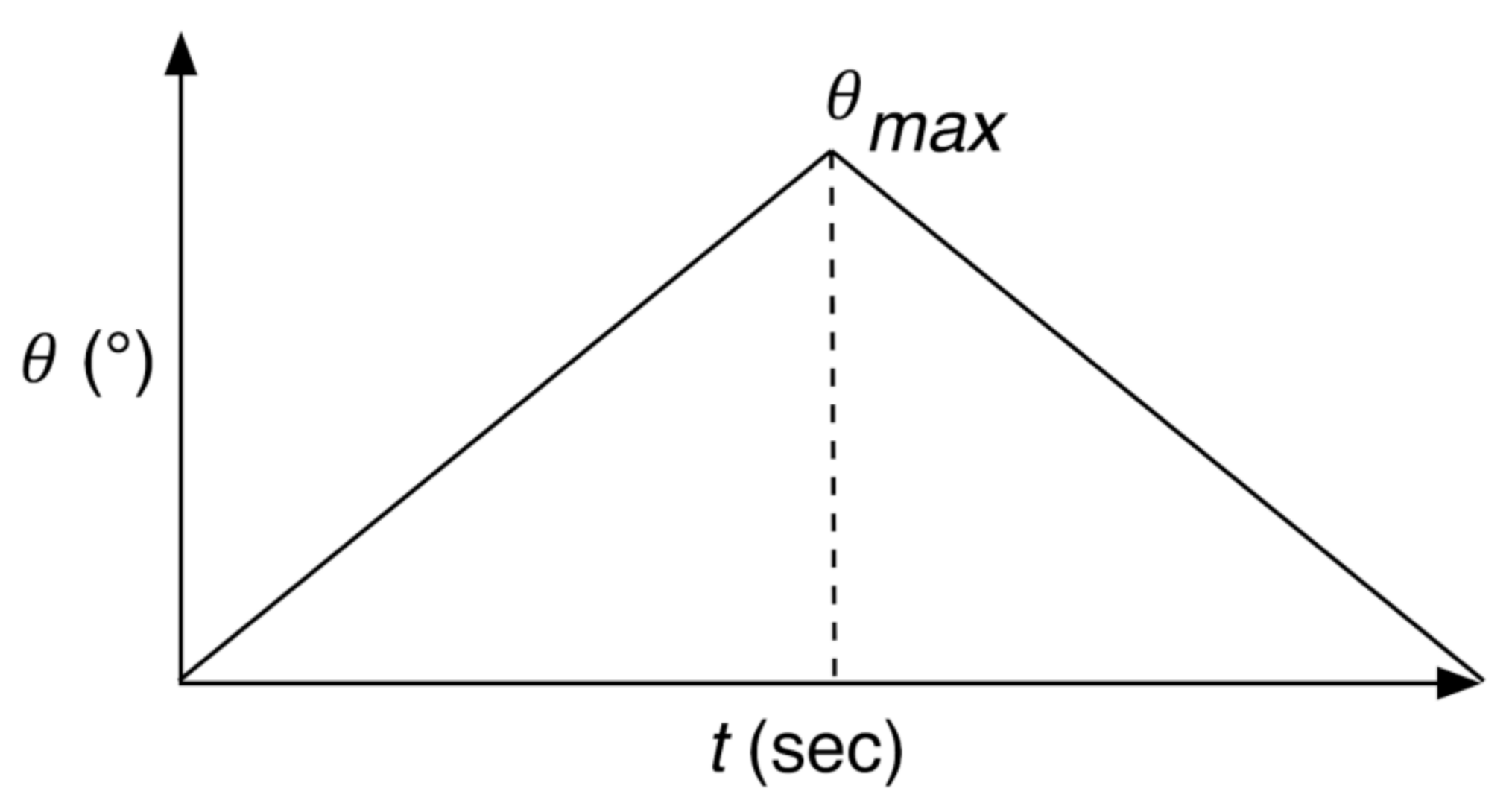
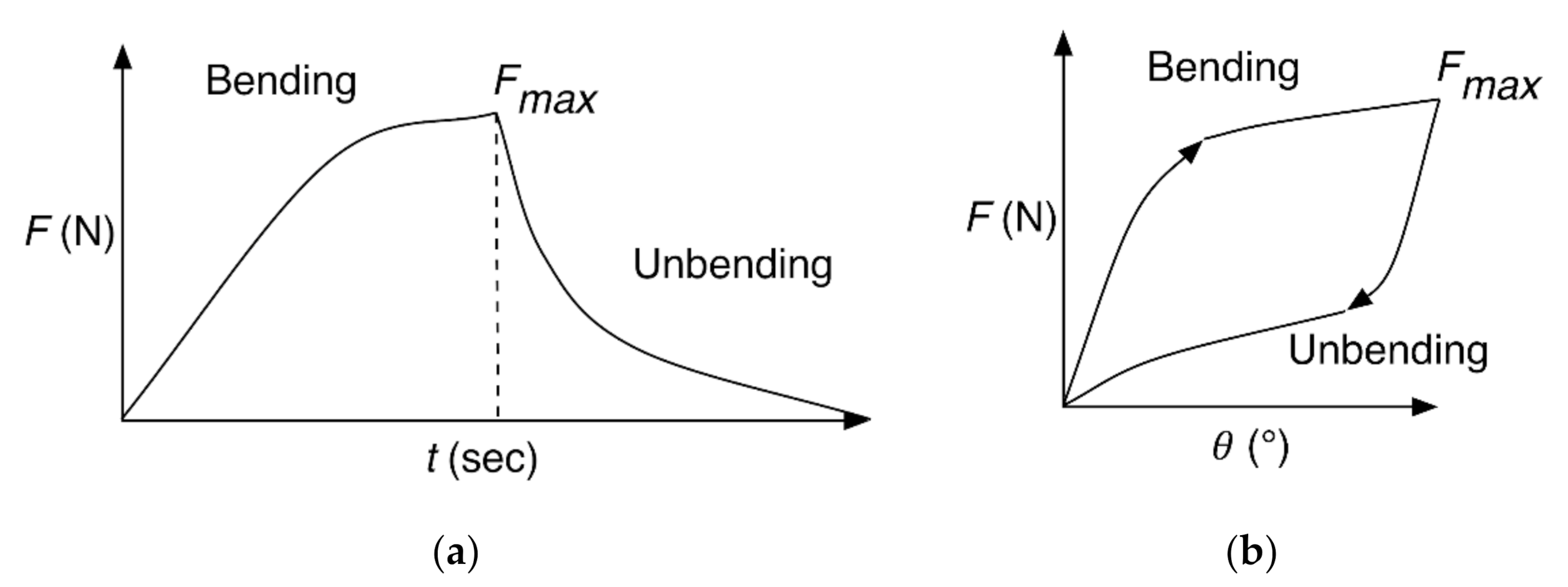
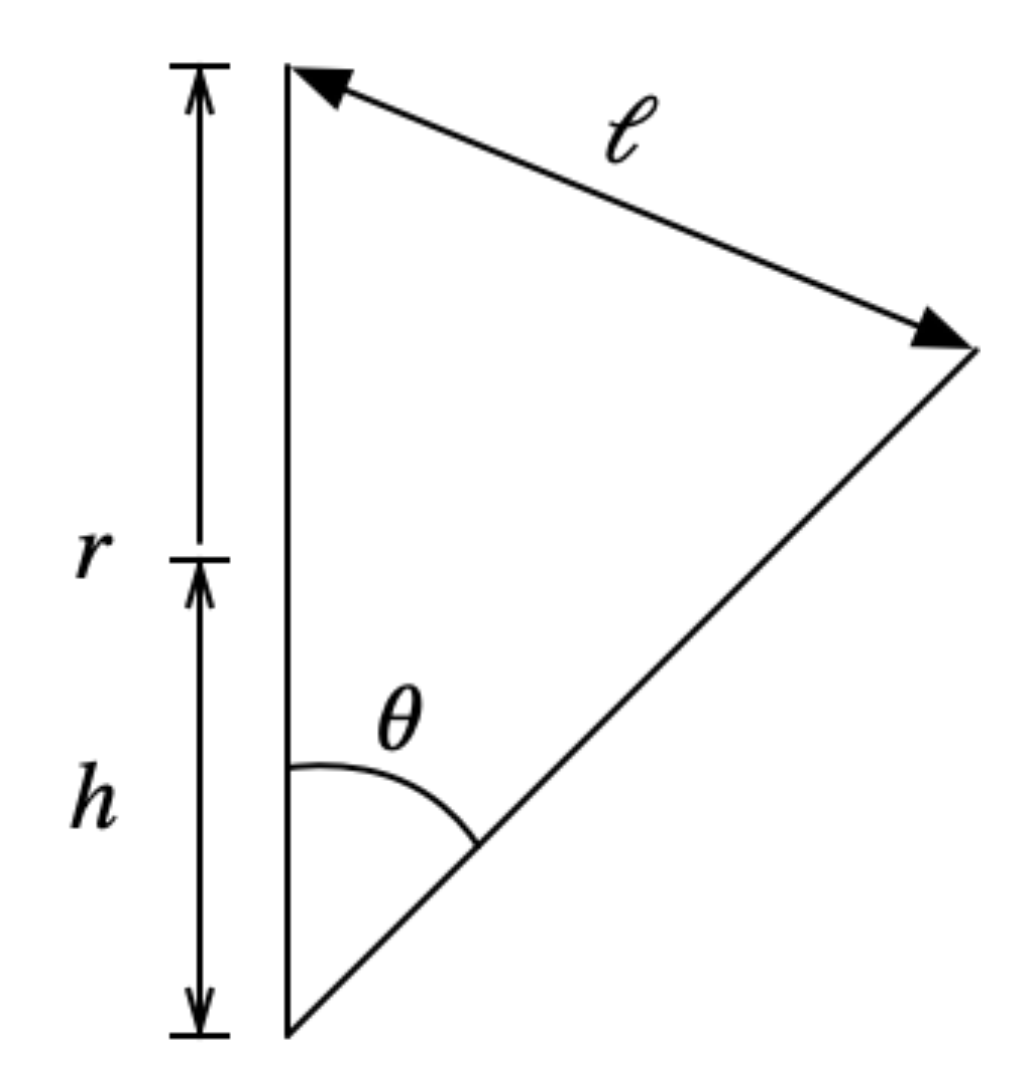
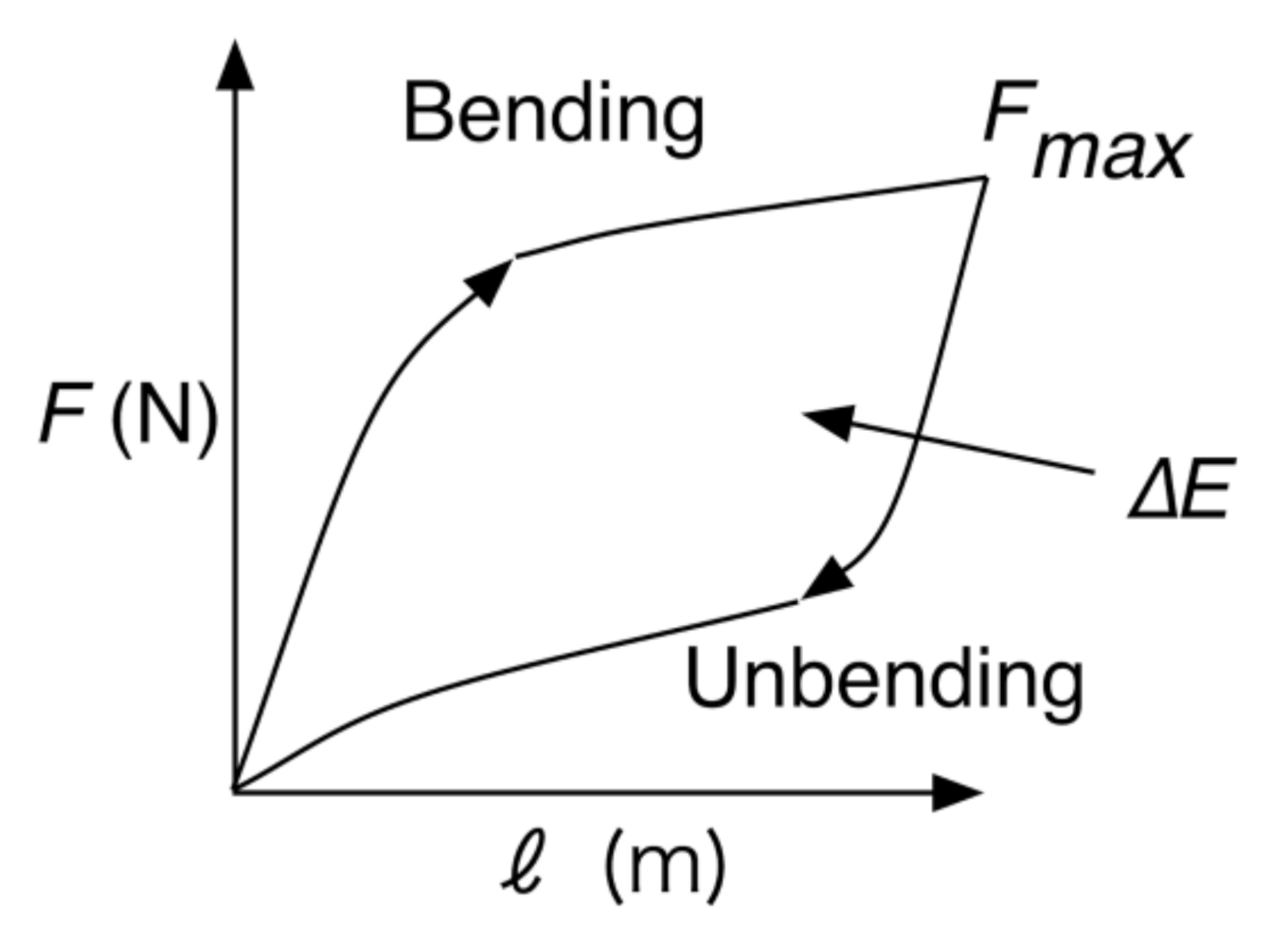
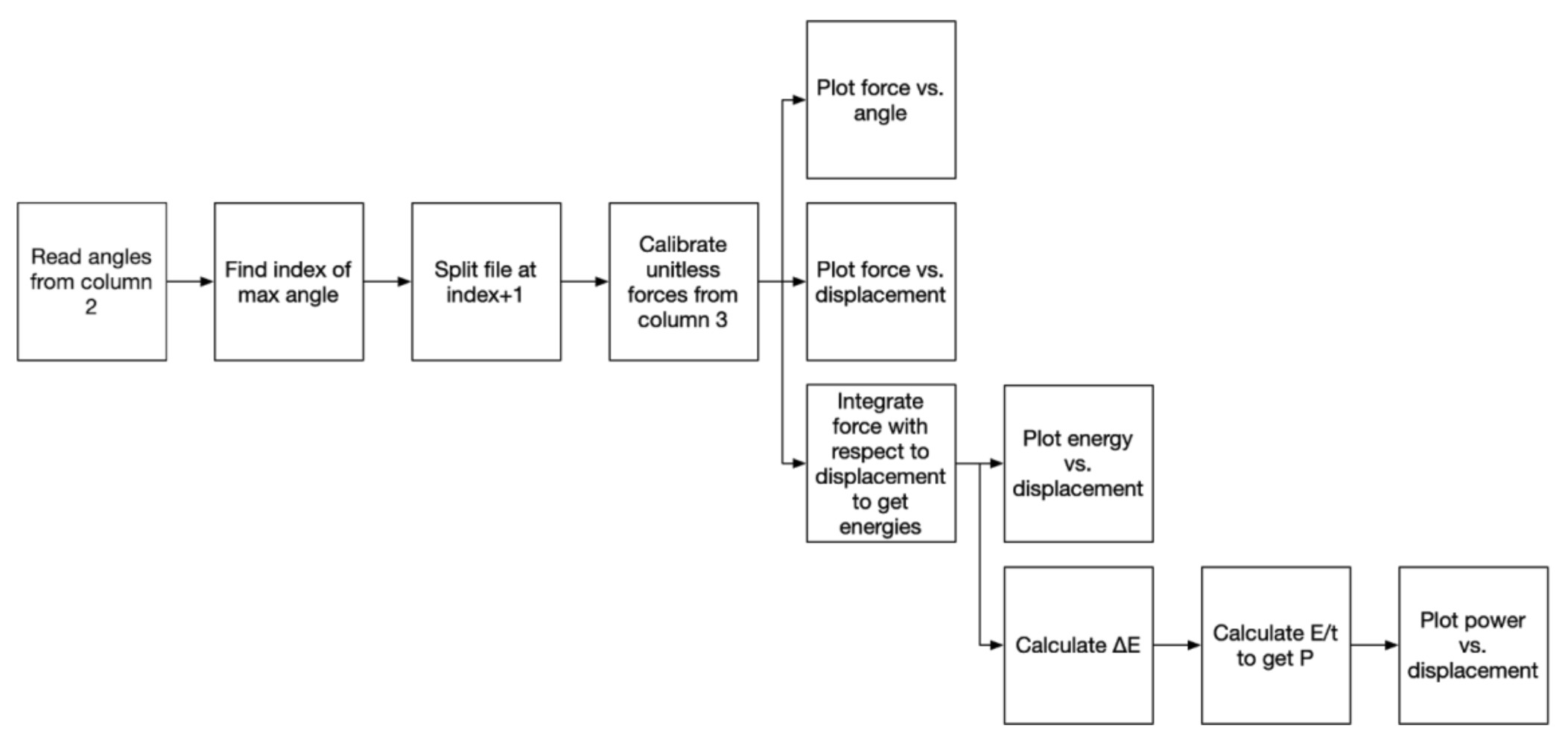
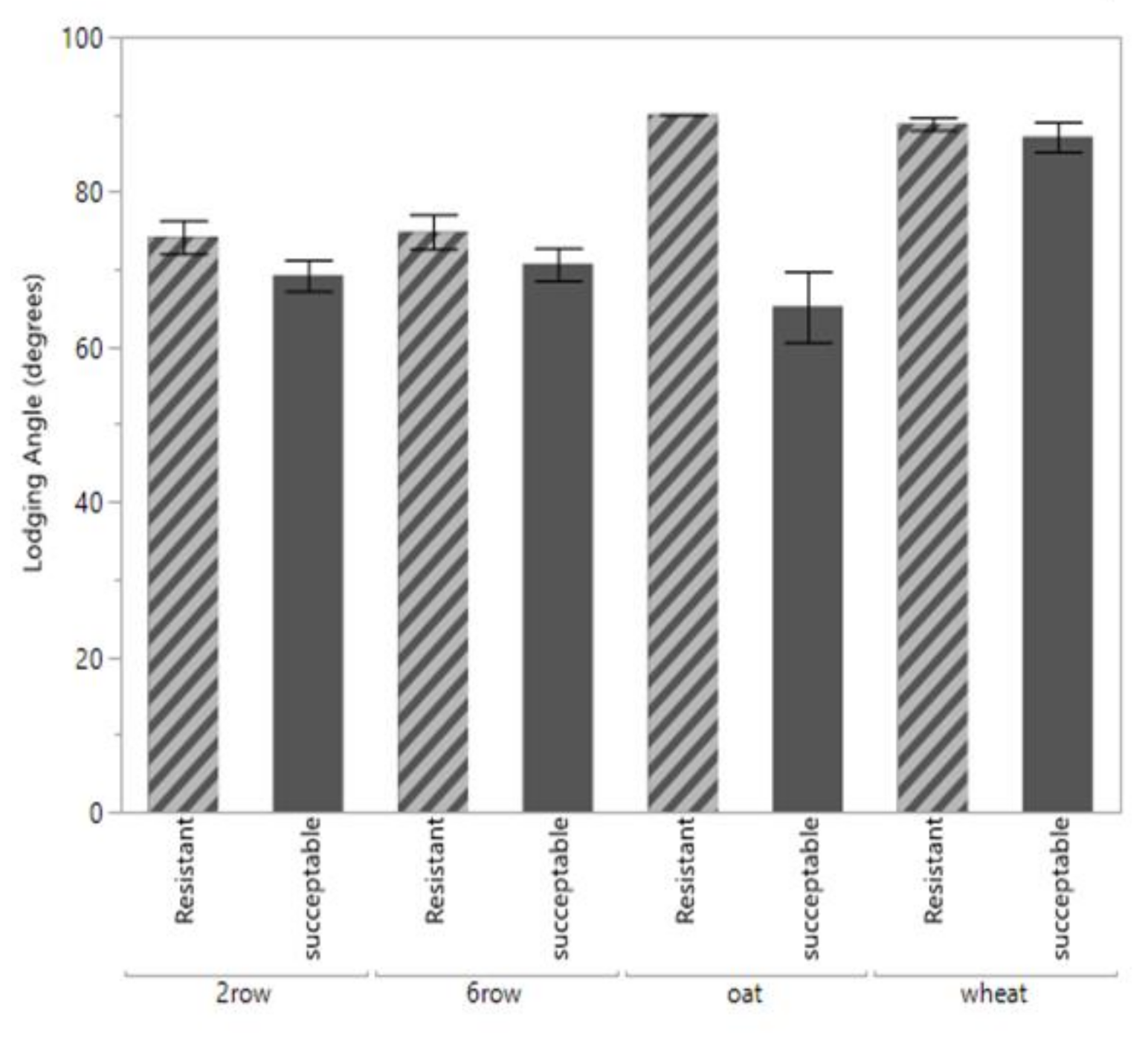
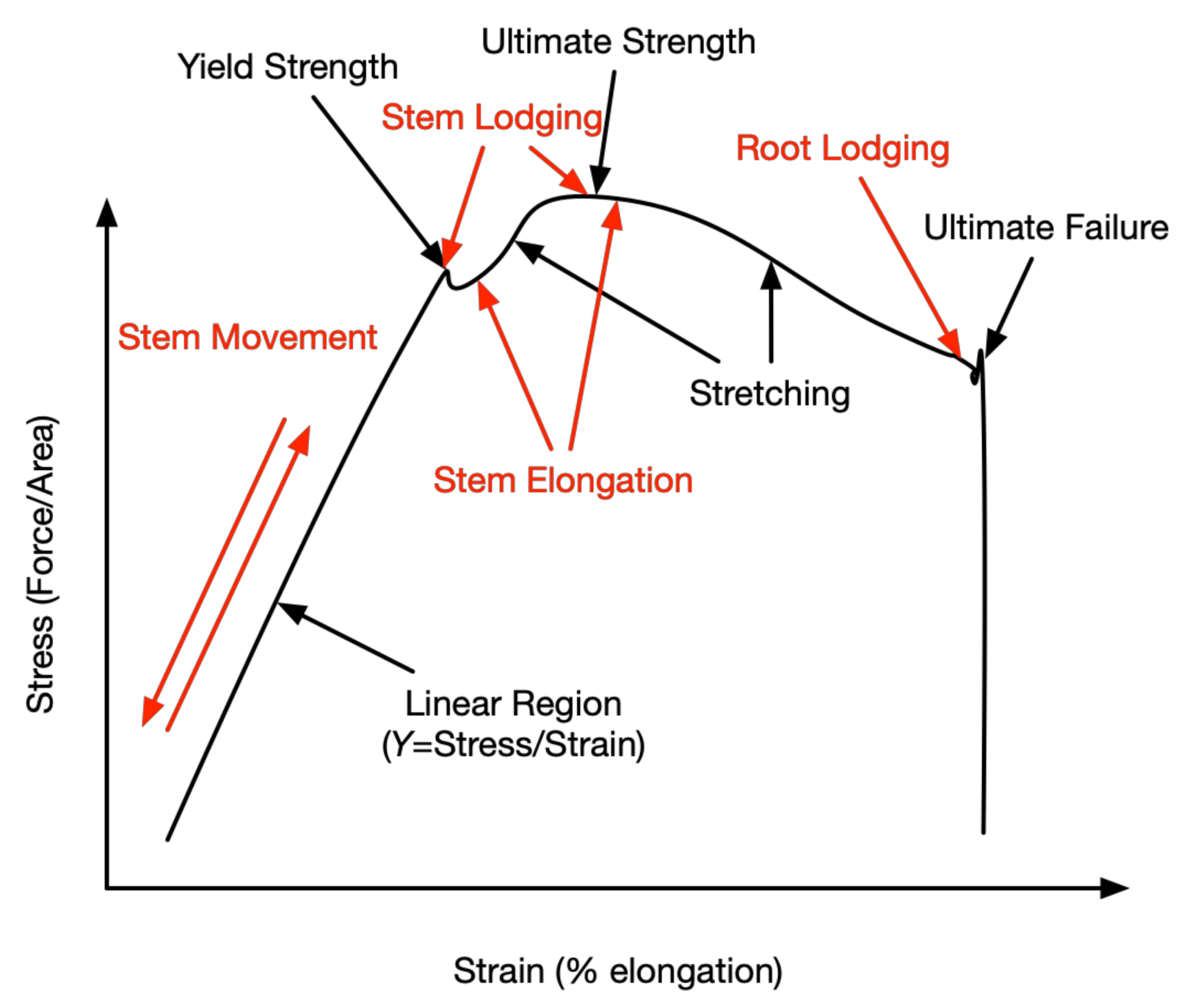
| Cultivar | Cereal Crop | Historic Lodging Classification |
|---|---|---|
| ND-Genesis | 2-row barley | Susceptible |
| AC-Metcalf | 2-row barley | Susceptible |
| Pinnacle | 2-row barley | Resistant |
| Conlon | 2-row barley | Resistant |
| Quest | 6-row barley | Susceptible |
| Celebration | 6-row barley | Susceptible |
| Stellar-ND | 6-row barley | Resistant |
| Tradition | 6-row barley | Resistant |
| Gopher | Oat | Susceptible |
| ND-021052 | Oat | Susceptible |
| IL-8721 | Oat | Resistant |
| Reins | Oat | Resistant |
| MN11394-6 | Wheat | Susceptible |
| Shelly | Wheat | Resistant |
| Rollag | Wheat | Resistant |
| Linkert | Wheat | Resistant |
| Column 1 | Column 2 | Column 3 |
|---|---|---|
| Time (msec) | Angle (°) | Force (unitless digital number) |
| Height (m) | Force (N) | Displacement (m) | Energy (J) | Power (mW) | ||||||||
|---|---|---|---|---|---|---|---|---|---|---|---|---|
| Growth Stage | Crop | Lodging Type | LS Mean | SE | LS Mean | SE | LS Mean | SE | LS Mean | SE | LS Mean | SE |
| Heading | 2-row | Resistant | 0.72b 1 | 0.02 | 5.25a | 0.81 | 0.51a | 0.02 | −8.64a | 9.7 | 3.51c | 1.3 |
| Susceptible | 0.74b | 0.02 | 6.53a | 0.99 | 0.52a | 0.02 | −40.09b | 11.9 | 5.83b | 1.6 | ||
| 6-row | Resistant | 0.75b | 0.04 | 6.51a | 0.85 | 0.53a | 0.02 | −12.25a | 10.6 | 2.60c | 1.4 | |
| Susceptible | 0.77ab | 0.03 | 7.20a | 0.88 | 0.52a | 0.03 | −10.08a | 10.6 | 4.75b | 1.4 | ||
| Oat | Resistant | 0.66c | 0.01 | 7.19a | 0.89 | 0.47b | 0.01 | −14.03a | 10.6 | 5.08b | 1.4 | |
| Susceptible | 0.78a | 0.03 | 8.44a | 0.85 | 0.53a | 0.02 | −21.90a | 10.1 | 4.03bc | 1.4 | ||
| Wheat | Resistant | 0.69b | 0.02 | 6.98a | 0.06 | 0.47b | 0.01 | −4.31a | 7.9 | 3.06c | 1.0 | |
| Susceptible | 0.71b | 0.01 | 8.20a | 1.15 | 0.48ab | 0.03 | −23.73a | 13.7 | 4.98bc | 1.8 | ||
| Mature | 2-row | Resistant | 0.73b | 0.02 | 5.00a | 0.81 | 0.50a | 0.02 | −5.43a | 9.7 | 6.53b | 1.3 |
| Susceptible | 0.75b | 0.02 | 5.30a | 0.81 | 0.52a | 0.02 | −39.85b | 9.6 | 11.60a | 1.3 | ||
| 6-row | Resistant | 0.78a | 0.04 | 5.47a | 0.81 | 0.51a | 0.03 | −5.48a | 9.7 | 7.12b | 1.3 | |
| Susceptible | 0.78a | 0.03 | 4.70b | 0.81 | 0.52a | 0.02 | −8.56a | 9.7 | 6.69b | 1.3 | ||
| Oat | Resistant | 0.68b | 0.02 | 7.29a | 0.85 | 0.44c | 0.02 | −15.08a | 10.1 | 7.76b | 1.4 | |
| Susceptible | 0.78a | 0.03 | 4.89b | 0.81 | 0.51a | 0.02 | −15.97a | 9.7 | 5.18b | 1.4 | ||
| Wheat | Resistant | 0.69b | 0.02 | 6.83a | 0.66 | 0.46b | 0.01 | −25.17a | 7.9 | 8.23b | 1.0 | |
| Susceptible | 0.72b | 0.01 | 1.87c | 1.15 | 0.48b | 0.01 | −1.95a | 13.70 | 3.56c | 1.8 | ||
| F-values | DF | Height | Force | Displacement | Energy | Power | ||||||
| Growth Stage | 1 | n.s | 18.36 *** | n.s. | n.s. | 17.68 *** | ||||||
| Crop | 3 | 4.61 ** 2 | n.s. | 4.86 ** | n.s. | n.s. | ||||||
| Lodging [Crop] | 4 | 5.33 ** | 2.86 * | 2.95 * | n.s. | 2.43 * | ||||||
| GS*Crop | 3 | n.s. | n.s. | n.s. | n.s. | n.s. | ||||||
| GS*L [C] | 4 | n.s. | 4.15 ** | n.s. | n.s. | n.s. | ||||||
| Model R2 | 15 | 0.19 ** | 0.21 *** | 0.17 ** | n.s. | 0.23 *** | ||||||
Publisher’s Note: MDPI stays neutral with regard to jurisdictional claims in published maps and institutional affiliations. |
© 2020 by the authors. Licensee MDPI, Basel, Switzerland. This article is an open access article distributed under the terms and conditions of the Creative Commons Attribution (CC BY) license (http://creativecommons.org/licenses/by/4.0/).
Share and Cite
Heuschele, D.J.; Garcia, T.A.; Ortiz, J.B.; Smith, K.P.; Marchetto, P. Cereal Stem Stress: In Situ Biomechanical Characterization of Stem Elasticity. Appl. Sci. 2020, 10, 7965. https://doi.org/10.3390/app10227965
Heuschele DJ, Garcia TA, Ortiz JB, Smith KP, Marchetto P. Cereal Stem Stress: In Situ Biomechanical Characterization of Stem Elasticity. Applied Sciences. 2020; 10(22):7965. https://doi.org/10.3390/app10227965
Chicago/Turabian StyleHeuschele, D. Jo, Taina Acevedo Garcia, Joan Barreto Ortiz, Kevin P. Smith, and Peter Marchetto. 2020. "Cereal Stem Stress: In Situ Biomechanical Characterization of Stem Elasticity" Applied Sciences 10, no. 22: 7965. https://doi.org/10.3390/app10227965
APA StyleHeuschele, D. J., Garcia, T. A., Ortiz, J. B., Smith, K. P., & Marchetto, P. (2020). Cereal Stem Stress: In Situ Biomechanical Characterization of Stem Elasticity. Applied Sciences, 10(22), 7965. https://doi.org/10.3390/app10227965





